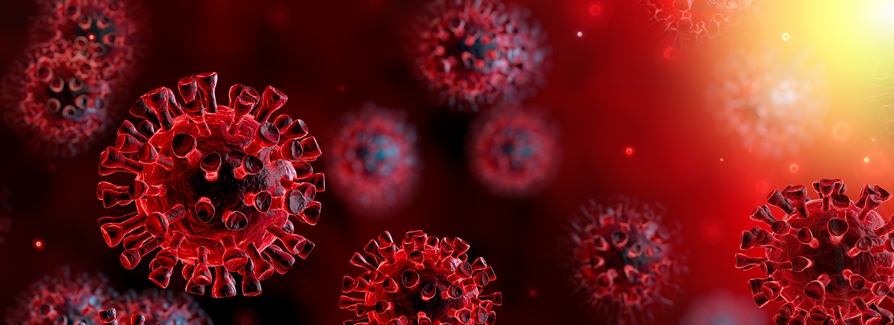Inside This Issue: ART adherence in Hispanic/Latino men, global progress in fighting HIV, COVID-19's impact on HIV testing, flu vaccination for people with HIV, COVID-19 research updates, and new educational resources.

Affected Population Groups
CDC Examines Barriers to ART Adherence Among Hispanic/Latino Gay and Bisexual Men
Adherence to antiretroviral therapy (ART) is essential for HIV viral suppression – a critically important outcome for maintaining the health of persons with HIV. Since Hispanic/Latino gay, bisexual, and other men who have sex with men (MSM) are disproportionately affected by HIV, CDC researchers recently studied the rates of ART adherence and barriers to adherence in this population group. For the study, CDC researchers analyzed ART adherence data from the Medical Monitoring Project (MMP) for the years 2015 through 2019 for Hispanic/Latino MSM with HIV. They found that, overall, about three-quarters (77.3%) of the Hispanic/Latino MSM interviewed across the MMP annual survey cycles had high adherence to their ART regimen in the month before their interview.
The most common reasons cited for missing doses of ART were forgetting to take HIV medicines (63.1%), a change in daily routine or travel (42.3%), falling asleep early or oversleeping (33.6%), and difficulty getting a prescription or refill (18.8%). Nearly two-thirds (63.9%) reported multiple reasons for missing ART doses.
The CDC researchers also found that the percentage of Hispanic/Latino MSM achieving high adherence varied by age, housing status, household income, and mental health status. In particular, young men and individuals with household income at or below the federal poverty less were less likely to have reported high ART adherence – 65.7% and 71.5%, respectively. Rates of high ART adherence were also lower among persons who were homeless (60.7%), as well as those who reported recent drug use (67.2%), depression (66.3%), generalized anxiety (69.5%), and unmet needs for services (71.6%).
“Expanding access to ancillary services among Hispanic/Latino MSM, particularly those experiencing barriers to ART adherence, might improve clinical outcomes,” according to the CDC researchers. “Co-locating these services with outpatient care (e.g., HIV patient-centered medical home model of the Ryan White HIV/AIDS Program) can encourage engagement and retention in HIV care.”
The Global HIV Epidemic
UNAIDS: Global Progress in Fighting HIV Falling Short of 2020 Goals
In 2016, the United Nations’ Political Declaration on Ending AIDS committed countries to the “90-90-90” targets for 2020, which are: 1) 90% of people with HIV will know their HIV status; 2) 90% of people diagnosed with HIV will be receiving HIV treatment; and 3) 90% of those receiving treatment will be virally suppressed. In a recent update, UNAIDS reports that substantial progress has been made toward the 90-90-90 goals in recent years. By the end of 2019, an estimated 81% of people with HIV knew their status, and fully two-thirds (67%) of the 38 million persons with HIV globally were on antiretroviral therapy. In addition, nearly 59% of people with HIV had suppressed viral loads in 2019.
However, achieving the 90-90-90 targets would require that a minimum of 73% of people with HIV have suppressed viral loads – a much higher figure than the 59% who had achieved this milestone by 2019. This means that the global targets for the end of 2020 are unlikely to be met, according to UNAIDS. In addition, the COVID-19 pandemic has the potential to halt or reverse some nations’ progress in fighting HIV by limiting access to HIV care and disrupting the supply of HIV medications, as well as necessities such as food.
COVID-19 Pandemic Has Significantly Reduced HIV Testing in Many Developing Nations
Since the start of the COVID-19 pandemic, UNAIDS, the World Health Organization, and the United Nations Children’s Fund have been collecting data to determine whether the pandemic has disrupted HIV testing services. A total of 56 countries have reported at least one month of HIV testing data during the period from January through July 2020, and 17 have supplied enough data to calculate trends over time. Of these 17 developing nations, all but one – Rwanda – reported large, sustained decreases in HIV testing services generally beginning in March or April, according to UNAIDS. Although HIV testing in five countries – Armenia, Madagascar, Mozambique, Myanmar, and Rwanda – had rebounded to pre-COVID-19 levels by July, HIV testing in most other countries remained significantly reduced – by as much as 80% to 90% in the case of Peru and Guyana.
%20small.jpg)
Living with HIV
The Importance of Flu Vaccination for People with HIV
The flu season in the U.S. typically begins in October, peaks between January and February, and continues through the winter into early spring. As the 2020-2021 flu season begins, HIV.gov has posted a blog item emphasizing the importance of flu vaccination for people with HIV. People with HIV have a relatively high risk for serious flu-related complications, particularly if they have a very low CD4 T-cell count or are not taking antiretroviral medications. For this reason, it is recommended that people with HIV get a flu shot annually.
Getting a flu shot is especially important this year, because of the health risks posed by COVID-19, and the danger that a concurrent flu epidemic and surge in COVID-19 cases could overburden the health care system. It is worth noting that the nasal spray flu vaccine is not recommended for people with HIV, because it contains a weakened form of the live influenza virus and might cause problems for those with a compromised immune system.
In addition to getting a flu shot, CDC advises that people with HIV follow other flu precautions recommended for everyone, including avoiding people who are sick, covering coughs, and washing hands often. CDC also has web pages in English and Spanish with additional information about the flu and people with HIV.

News About COVID-19
COVID-19 Research from NIAID
During the past month, the National Institute of Allergy and Infectious Diseases has published research focusing on COVID-19 disease, as well as ongoing or planned clinical trials evaluating preventive vaccines or treatments for persons already infected. For your convenience, we are linking to these articles below:
- Scientists Discover Genetic and Immunologic Underpinnings of Some Cases of Severe COVID-19
- Investigational COVID-19 Vaccine Well-Tolerated and Generates Immune Response in Older Adults
- Fourth Large-Scale COVID-19 Vaccine Trial Begins in the United States
- NIH Study Aims to Identify Promising COVID-19 Treatments for Larger Clinical Trials
- NIH Clinical Trial Testing Hyperimmune Intravenous Immunoglobulin Plus Remdesivir to Treat COVID-19 Begins
- Bulletin: NIAID Stops Enrollment of Severely Ill COVID-19 Participants in Clinical Trial of Investigational Treatments
Latest COVID-19 Reports from MMWR
CDC’s Morbidity and Mortality Weekly Report (MMWR) is also continuing to provide extensive coverage of COVID-19-related research. The reports are aggregated on a page devoted to studies about COVID-19, and summarized in a weekly podcast. For your convenience, we have grouped recently published MMWR reports on COVID-19 into several subtopics below:
Prevention and Pandemic Response
- CDC Deployments to State, Tribal, Local, and Territorial Health Departments for COVID-19 Emergency Public Health Response – United States, January 21-July 25, 2020
- COVID-19 Contact Tracing in Two Counties – North Carolina, June-July 2020
- Trends in COVID-19 Incidence After Implementation of Mitigation Measures – Arizona, January 22-August 7, 2020
- Characteristics Associated with Adults Remembering to Wash Hands in Multiple Situations Before and During the COVID-19 Pandemic – United States, October 2019 and June 2020
Demographics
- Changing Age Distribution of the COVID-19 Pandemic – United States, May-August 2020
- Transmission Dynamics by Age Group in COVID-19 Hotspot Counties – United States, April-September 2020
- COVID-19 Trends Among School-Aged Children – United States, March 1-September 19, 2020
- Recent Increase in COVID-19 Cases Reported Among Adults Aged 18-22 Years – United States, May 31-September 5, 2020
- Factors Influencing Risk for COVID-19 Exposure Among Young Adults Aged 18-23 Years – Winnebago County, Wisconsin, March-July 2020
- Update: Characteristics of Health Care Personnel with COVID-19 – United States, February 12-July 16, 2020
- Demographic Characteristics, Experiences, and Beliefs Associated with Hand Hygiene Among Adults During the COVID-19 Pandemic – United States, June 24-30, 2020
Case Clusters/Outbreaks
- Multiple COVID-19 Clusters on a University Campus – North Carolina, August 2020
- An Outbreak of COVID-19 Associated with a Recreational Hockey Game – Florida, June 2020
- Adolescent with COVID-19 as the Source of an Outbreak at a 3-Week Family Gathering – Four States, June-July 2020
Health Risks, Outcomes, and Related Issues
- Case Series of Multisystem Inflammatory Syndrome in Adults Associated with SARS-CoV-2 Infection – United Kingdom and United States, March-August 2020
- Disparities in COVID-19 Incidence, Hospitalizations, and Testing, by Area-Level Deprivation – Utah, March 3-July 9, 2020
 Educational Resources
Educational Resources
HRSA Publishes Guides on HIV Care for Older Persons with HIV
In 2018, nearly half (46%) of all clients in the Ryan White HIV/AIDS Program (RWHAP) were aged 50 years or older. To help RWHAP recipients, subrecipients, and providers meet the needs of these older clients, HRSA’s HIV/AIDS Bureau (HAB) recently published the following brief reference guides:
Optimizing HIV Care for People Aging with HIV: Incorporating New Elements of Care – This 5-page guide provides background information about older persons with HIV, and highlights the specific health and social challenges, gaps in the medical management, and health screening tools available for this growing population group. An extensive list of references is also included. According to HAB, this guide “serves as a starting point for health care teams as they build and expand their knowledge and practice of serving people aging with HIV.”
Optimizing HIV Care for People Aging with HIV: Putting Together the Best Health Care Team – This 4-page guide outlines a multi-disciplinary approach for providing high-quality HIV care to older persons with HIV. It focuses on the roles and responsibilities of different health care providers who serve older persons with HIV, the specific staff training needs of those serving older patients and clients with HIV, and the organizational capacity and resources necessary to ensure that this population receives optimal care.
New AIDSVu Resources Focus on HIV Among Hispanic/Latinx People
In conjunction with National Latinx AIDS Awareness Day, the AIDSVu website recently posted a blog item highlighting the impacts of HIV on Hispanic/Latinx people, plus a new set of infographics about HIV in this population group. These include infographics about:
- the disproportionate share of new HIV diagnoses among Hispanic/Latinx people;
- the lower viral suppression rates among Hispanic/Latinx people and Blacks compared to Whites;
- the relatively high percentage of late HIV diagnoses among Hispanic/Latinx people;
- the proportion of Hispanic/Latinx persons who have ever been tested for HIV;
- the differing trends in rates of new HIV diagnoses between Hispanic/Latinx women and men; and
- for Hispanic/Latinx people, the percentage of all new HIV diagnoses that occurred among gay and bisexual men, as well as trends by age group.




%20small.jpg)